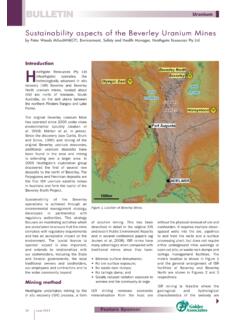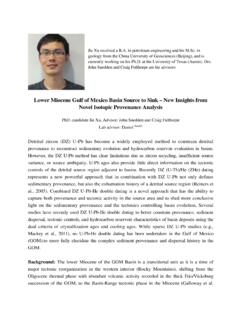Transcription of The Bushveld Complex in the Context of theThe Bushveld ...
1 The Bushveld Complex in the Context of theThe Bushveld Complex in the Context of the Geology of South Africa s kaapvaal Craton The kaapvaal Craton is a fragment of the Earth s crust and underlies almost half of South Africa. To the North it is separated from the Zimbabwe Craton by the highly metamorphosed rocks of the Limpopo Belt. The Craton began to form about 3 600 MaThe Craton began to form about 3 600 Ma ago and suffered little deformation for more than 2 600 Ma. However the Archaean basement is now largely covered by younger krocks The craton is the host of the world s number one resources of Au, PGE, V- and Mn-ores and also contains large reserves of iron-ores, g,uranium, vermiculite, fluorspar and copper. Worldwide distribution of Archaean cratonsWorldwide distribution of Archaean cratons older than 2 500 Ma.
2 Many of these cratons carry world-class ore-deposits. It underlines the importance of the Archaean as athe importance of the Archaean as a metallogenetic Map of north-eastern South Africa exhibiting the area underlain by the kaapvaal CratonMaMa1402 050 MaBushveld and Palaborwa ComplexesMa2 050 EoproterozoicBushveld and Phalaborwa Complexes100120Ma2 500Eo-proterozoicPhanerozicMa02 500 EoproterozoicManganese and iron ores of the Transvaal Supergroup80100 Phanerozoic02 500 Neo-hPhanerozic545 Neo-archaean6080 Phanerozoic5452 800archeanMeso-Witwatersrand Au-U-oresProterozoic2 800 MesoWitwatersrand gold-uranium deposits4060 Proterozoic3 200 Meso-archaeanAu-ores ingreenstone belts2 5003 200 Meso-archaeanPrimary gold-deposits associated with greenstone belts20 Archaean2 500 Palaeo-archaeanArchaean3 600 Palaeo-archaeangreenstone belts0caea3 6003
3 600 Eoarchaean3 600 EoarchaeanStratigraphic positions of major ore mineralisations in the kaapvaal CratonStratigraphic positions of major ore mineralizations in the kaapvaal CratonGeological map of the Barberton greenstone blthithitff thjbeltshowing the sites of some of the major gold mines. A: Consort; B: Sheba; C: Fairview; D: Agnes. The belt hosts some of the oldest recognised gold ores on Earthrecognised gold ores on Earth. In the kaapvaal Craton greenstone belts are best exposed in the north-east of South Africa. They often form linear shaped structures deeply infolded into the granitic gneisses which dominate the Archaean terraneArchaean terrane. The belts formed between 3 500 and 3 000 Maand at their base consists of mafic volcanics overlain by sedimentary rocks such as co s s s oa c o ca cs o e a by sed e a y oc s suc asshales, greywackes, cherts, banded iron-formations and conglomerates.
4 The first primary gold mineralization in the country was discovered at Eersteling in the Pietersberg Belt in 1871. However, the largest gold mines occur in the Barberton Belt and since 1884 produced aboutmines occur in the Barberton Belt and since 1884 produced about 320 t of gold. The mesothermal gold ores aregenerally associated with ggyincompetent sedimentary rocks. They form sulfide bearing gold-quartz veins and in the Barberton Belt exhibit an age of about 3 100 Ma. The Murchison Beltcontains the largest known Archaean antimony depositnow mined by Metorex Ltd. It has an age of 2 900 Ma and occurs asquartz-carbonate-stibnite veinsin tension fracturesoccurs as quartzcarbonatestibnite veinsin tension fractures. Barbrook Mine, BarbertonPillow lavas of the Onverwacht GroupAlgoma-type banded iron-formation (BIF) of the Fig Tree GroupSimplified Geological Map of Witwatersrand GoldfieldsThe Witwatersrand The Witwatersrand near Johannesburg The intercratonic Witwatersrand Basin contains the largest known gold deposit on EarthSince its discovery in 1886 this deposit yielded more than50 000deposit on its discovery in 1886 this deposit yielded more than 50 000 t of gold, or about 40% of all the gold ever mined by mankind.
5 Remaining gold resources are about 36 000 t or 40% of the world s total gold Idditith B ilt i350 kt firesources. In addition the Basin also contains some 350 kt of uranium resources. The gold reefs occur in the 7 000 thick pile of shales and conglomerates forming the 2 900 to 2 700 Ma old Witwatersrand Supergroup. 2 900 to 2 700 Ma old Witwatersrand Supergroup. Sedimentation took place in shallow waters by riversthat flowed into the basin from highlands to the north and north-east depositinglarge fluvial fans which can be correlated with the major present goldfieldsbe correlated with the major present goldfields. Rounded pyrite and uraninite particles associated with goldoccur in the con-glomerate matrix and most investigators regard them as being of detrital ggggginterpretation was recently substantiated by rhenium-osmium age dating of gold particles which yielded an age of 3 030 Ma, an age older than that of the conglomerates confirming the placer origin of the confirming the placer origin of the gold.
6 Detrital pyrite and uraninitewhich are not stable under present day atmospheric conditions speak for the existence of an oxygen-poor atmosphere during the AhThhtidi ithd ftWittArchaean. The change to an oxidizing atmosphere occurred after Witwaters-rand times in an interval lasting from 2 300 to 1 700 Ma. Thus, Witwatersrand type gold-uranium placers can only be found in sediments older than 2 300 Ma. So far they have also been recognized in the Blind River conglomerates of Canada and in the Brazilian Serra Jacobina conglomerates. 6 cmMatrix-supported conglomerate with large vein-quartz pebbles. Note: pyrite together with gold and other heavy minerals occur in matrixVentersdorp Contact Reef overlain by metabasalts: Mponeng Mine Outcrop of Witwatersrand conglomerates at Rietkuil, West Rand Open stope at Saaiplaas Manganese ore in paleocarst, Kalahari Manganese FieldSOThabazimbiTransvaal SupergroupSishen Mine; Kumba Iron OreTransvaal Supergroup 2 650 2 050 Ma:Thabazimbi and Sishen: Fe-oresKalahari Manganese FieldsSishenNorthern Cape: AsbestosMn-fieldsGeological map of north-eastern South Africa showing localities of iron-ore deposits, manganese ores and asbestos deposits The Transvaal Supergroupwith an age of 2 650 to 2 220 Ma consists of a thick pile of chemical and clastic sediments and minor pvolcanics.
7 In it lower part quartzites, cherts and carbonate rocks with interbedded banded iron-formation (BIF)predominate. They are li b hldtidl itdifoverlain by shales, sandstones, minor dolomites and manganiferous ironstones in the west. Thecarbonate sedimentsare of special interest as they contain wellThe carbonate sedimentsare of special interest as they contain well preserved stromatolite structuresformed from blue-green algae. Through oxygen producing photosynthetic processes these primitive life-forms were instrumental in the conversion of the early reducing atmosphere to an oxidizing one. The chemical sediments are economically of special interest as they The chemical sediments are economically of special interest as they carry extensive BIF-horizons which at Sishen and Thabazimbi form world-class iron deposits.
8 In the Northern Cape along the ppgwestern margins of the craton the dolomites contain more than 80% of the world s known land-based resource of manganese metal. The iron- and manganese deposits of the Transvaal Supergroup formed as a result of the rapid increase of free oxygen in theformed as a result of the rapid increase of free oxygen in the Earth s atmosphere. During the Archaean the ocean waters carried abundance of soluble ferrous iron and any oxygen produced by early blue-green algae was rapidly taken up by the oxidation of yggpy pyferrous to insoluble ferric iron which precipitated to eventually form BIF-ores. At around 2 300 Ma dissolved ferrous iron began to be depletedAt around 2 300 Ma dissolved ferrous iron began to be depleted and manganese began to precipitate to form the primary deposits of the Kalahari Manganese Fields.
9 Iron-ore deposits of the BIF-type form the world s most importantIronore deposits of the BIFtype form the world s most important iron resource. They are chemical sediments, have an age of 2 500 to 1 800 Ma and formed in sea waters as a result of the increased oxygen production released by early photosynthetic primitive life-oxygen production released by early photosynthetic primitive lifeforms. The deposits occur world-wide on many Archaean cratons, the itabirites of the Quadril tero Ferr fero in Brazil, the Hamersley Iron Province in Australia, or the Superior Province of Canada. ,pThabazimbi Mine, Kumba Iron OreManganese Fields, Mamatwan MineStromatolitic Malmani dolomites, Transvaal Supergroup, Sudwala PassGreat Escarpment formed by Transvaal Supergroup near Pilgrims RestImpala PlatinumBhldC lBushveld Complex :PGE, Cr, V, FluoriteGeological map of north-eastern South Africa indicating positions of western, eastern and northern limbs of Bushveld ComplexBushveld lithostratigraphy and positions of mineral depositsLebowa Granite SuitegranitescassiteriteSnRashoop Granophyre Suitegranophyres, porphyritic granitestit lMain Magnetite Layer at SteelportRustenburg La eredMain Zone(norites, Upper Zone(diorite, gabbronorite magnetite layers) magnetite layers cont.)
10 VanadiumV2O5UG2 LayeredSuiteCritical Zone(norites, pyroxenites, anorthosites, chromitites)(gabbronorites, MRUG2 PGEchromitite seamsCrMerensky Reefchromitites)Lower Zone(pyroxenites, dunites, harzburgites, bronzitite)chromitite seamsCrRooiberg Marginal Zone(norites, pyroxenites)rhyolites, dacites, flitFgGroupbasaltic andesitesfluoriteFchromitite layers at Jagdlust The 2 060 Ma old Bushveld Complexof about 66 000 km2extent is a saucer-shaped layered igneous intrusion and one of the great geological wonders of the world. The Complex is made up of ultramafic to felsic igneous rocks and formed by repeated injection of magma into an enormous chamber. Cooling and fractional mineral crystallisation was a slow process leading to the mineral accumulation into differentcrystallisation was a slow process leading to the mineral accumulation into different sub-horizontal layers or group of layers.



